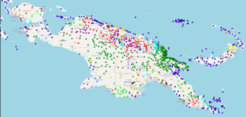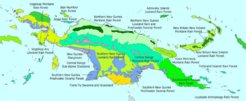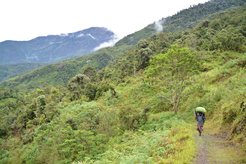The (un)Likely Link Between Environment & Languages
To what extent does climate impact human behavior?

Linguistic diversity in New Guinea (map after Glottolog 3.0, https://glottolog.org/) is one of the highest in the world (each occurrence point in the map corresponds to the approximate geographical center point of the geographical area where a given language is spoken) most of which belong to either the Trans New Guinea language family (dark green dots) or the Austronesian language family (dark blue dots). The vertical line in the center of the Main Island of New Guinea represents the international border between Papua New Guinea in The East and the Indonesian Provinces of Papua and West Papua in the West.
Environmental factors condition the distribution of plant and animal species, but to what extent do they impact human behavior? The debate on climatic determinism was already heated between the philosophers Montesquieu and Voltaire in the 18th century1. It also received special attention in more recent studies2, which show a decreasing linguistic diversity from the equator towards the poles and suggest that environment does influence linguistic geography, and by extension human culture. These findings oppose alternative explanations for language diversity such as population dynamics, migrations, drift and psycho-socio-cultural mechanisms and demonstrate that a consensus is still lacking as to what factor(s) influence present day language distributions.

Map of ecoregions in New-Guinea after the World Wide Fund For Nature (©WWF https://wwf.panda.org/knowledge_hub/where_we_work/new_guinea_forests/area_forests_new_guinea/)
Using an original, multivariate statistical approach based on methods borrowed from biodiversity studies3, a French-German team4 tackled the issue concerning the possible link between environment and language distributions at a detailed regional scale in New Guinea and obtained three interesting results, now published in PLOS ONE5.
First, their approach, which they coined “Eco-Linguistic Niche Modeling”, offers, for the first time, a means to simultaneously take into account a range of environmental variables and to test their influence on each linguistic group independently, i.e., without assuming that environmental variables will influence all linguistic groups in the same way, regardless of the specific subsistence strategies and socio-cultural adaptations of the speakers. Interestingly, the 29 investigated language groups of Mainland and Island New Guinea show different types of environmental correlations.

Second, they found that most language groups share their eco-linguistic niche with other language groups. This suggests that there is no clear correlation between environment and the geographical distribution of language groups. Other factors, such as those depending on psycho-socio-cultural aspects of human behavior, most likely play a more decisive role in language diversification.
Third, and in contrast to what is observed for language groups, language families show only minor niche overlap. This may indicate that environment does influence the expansion and distribution of languages belonging to the same language family.
These findings should have important implications for future ethno-linguistic, ethno-archaeological and archaeological research in New Guinea and elsewhere, as it offers a common framework in which high-resolution environmental, linguistic and psycho-socio-cultural variables can be correlated in a systematic way.
It is hoped that ultimately the fascinating aspects of human linguistic and cultural diversity will be better understood.
##
1 cf. Montesquieu 1748, De l´Esprit des lois and Voltaire 1752, Pensées sur le gouvernement.
2 eg. Nettle 1998. Journal of Anthropological Archaeology 17: 354 (https://doi.org/10.1006/jaar.1998.0328) and Hua et al. 2019. Nature Communications 10: 2047 (https://doi.org/10.1038/s41467-019-09842-2).
3 “Ecological Niche Modelling” is a method used in ecology to define the optimal environmental conditions for an animal or a plant species. To define these niches, the method uses predictive algorithms, occurrence points of species and numerous bioclimatic and topographic variables. This method was adapted (to become “Eco-Linguistic Niche Modelling”) and applied to define the range of environmental conditions present in the territory of a population speaking a given language or group of languages characterised by common language traits.
4 with grants of the “Laboratoires d´Excellence Sciences archéologiques de Bordeaux” (LaScArBx Cluster of Excellence) supported by the French Agence National de la Recherche (ANR-10-LABX-52), the German Max Planck Institute for Ornithology – Seewiesen, the French “Programme Investissements d’Avenir (IdEx)” of the Bordeaux University, and the Research Council of Norway through its Centre of Excellence funding scheme, SFF Centre for Early Sapiens Behaviour (SapienCE).
5 Nicolas Antunes, Wulf Schiefenhövel, Francesco d’Errico, William E. Banks, Marian Vanhaeren. Quantitative methods demonstrate that environment alone is an insufficient predictor of present-day language distributions in New Guinea. PLOS ONE. https://journals.plos.org/plosone/article?id=10.1371/journal.pone.0239359


